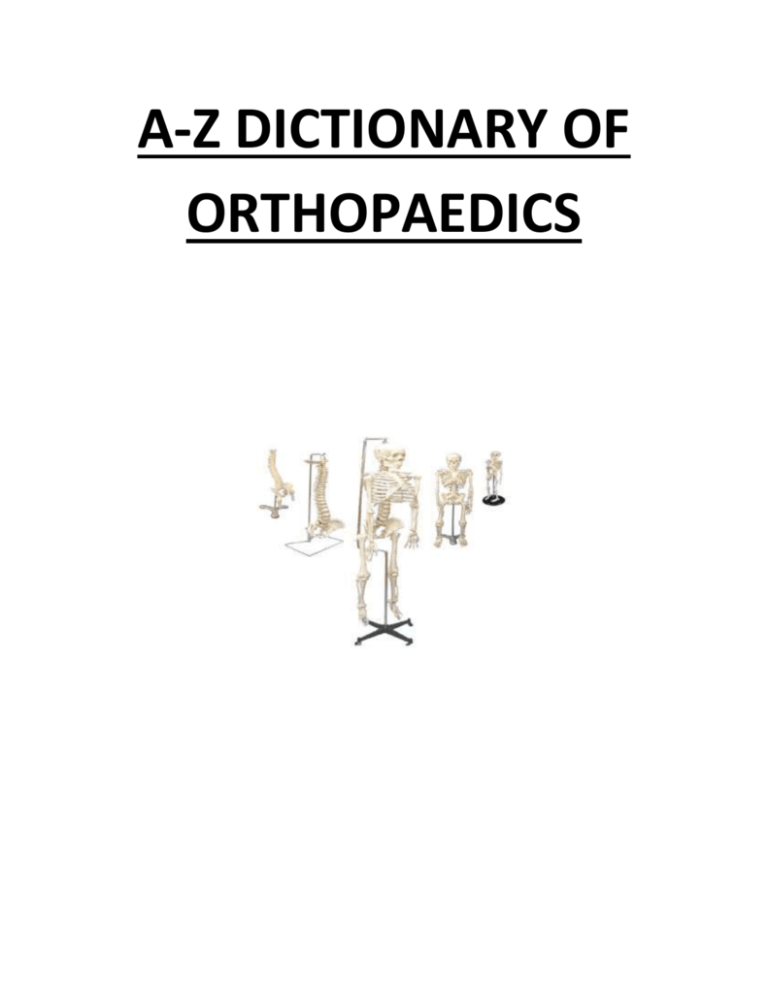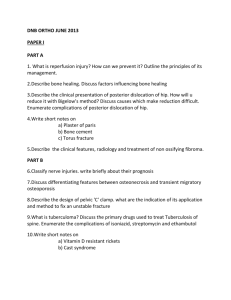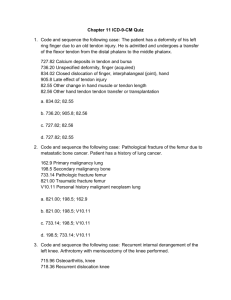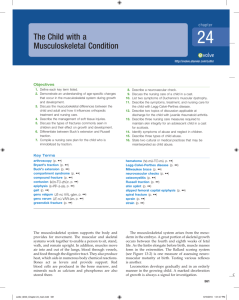az dictionary of orthopaedics
advertisement

A-Z DICTIONARY OF ORTHOPAEDICS Aa Abduction :- Movement of a limb away from the midline of the body. Adduction :- Movement of a limb toward the midline of the body. Ankilosing Spondylitits :- Chronic inflammation of articular cartilage, synovium and ligaments eventually becoming ossified. Mainly affecting the joints of the spinal column and occasionally the major limb joints. AO screws :- Used in the fixation of extra capsular fractured necks of femur where circulation is not impaired. Arthrodesis :- Fusion of a joint. Arthroplasty :- Operation for construction of a new moveable joint such as a hip or knee. 3 types :- 1) Excision arthroplasty eg girdle stones. 2) Half joint arthroplasty (hemi) eg Austin Moores, Thompsons hip prosthesis. 3) Total replacement arthroplasty eg. Total hip, knee replacement Arthroscopy :- Inspection of the interior of a joint through a fine telescope introduced through a cannula. Austin Moores :- See half joint arthrosplasty. Bb Bakers Cyst :- Herniation of the synovial cavity of the knee with the formation of a fluid filled sac. Bradford Sling :- Used for elevation of upper limbs usually to reduce and relieve swelling. Braun Frame :- Used for elevation of lower limbs to reduce oedema, or for application of traction to the lower end of the tibia. Bursae :- Small sacs of connective tissue located wherever pressure is exerted on moving parts. Bursitis :- Inflammation of a bursa. Cc Carpal Tunnel Syndrome :- Constriction of the median nerve in the carpal tunnel, causing discomfort in the hand. It is caused by thickening of the tendon sheaths. Cartilage :- Strong and flexible covering of the articular surfaces of the bone which also serves as a cushion. Chondroma :- A tumour composed of cartilage. Colles fracture :- Fracture of the lower end of radius with a characteristic displacement of the lower fragment backwards and upwards. Compartment syndrome :- Swelling occurring within a muscular fascial compartment which occludes the vascular system supplying the muscles, causing ischaemia. Immediate surgery is necessary to decompress the whole compartment. CPN (continuous passive movement):- A machine that provides continuous movement of a joint without any effort on the part of the patient. Cruciate ligaments :- Anterior and posterior ligaments of the knee. Dd De Quervains :- Fibrous sheaths of the wrist tendons thicken causing pain when using the hand. Discectomy :- Removal of a complete vertebral disc (usually prolapsed or ruptured) which provides cushioning between the vertebrae. Dupytrens Contracture :- Thickening and shortening of the palmar fascia, causing flexion contracture of one or more fingers. Ee Exostosis :- Hard uneven lumps found at the end of long bones, can become hugely visible especially around the knee. External fixation :- Immobilisation of a fracture by rigid anchorage of the bone fragments to an external device using metal pins and frames. Ff Fascia :- A sheet of loose connective tissue found directly under the skin (superficial) or as a sheet of dense, fibrous tissue making up the sheath of muscle, nerves and blood vessels ( deep). Fat embolism :- Occurs mainly after sever fractures in long bones usually within 48 hrs of injury. Caused by the occlusion of small vessels by fat globules released from the fracture site. Fibroma :- A firm, rounded painless nodule often found on the trunk. Gg Ganglion :- Thin walled sac filled with viscous fluid which appears as a subcutaneous swelling. Girdlestones :- The head and neck of femur is excised, the side wall of the pelvis is smoothed and a flap of muscle placed between the shaft of femur and the pelvis to create a painless false joint. Gout :- A disturbed purine metabolism, characterised by deposition of uric acid salts in connective tissues such as cartilage, the walls of bursae and ligaments. Hh Hip replacement :- See Arthroplasty. Hamilton Russel traction :- Traction used for any condition about the hip for which continuous traction is required resulting in pull in line with the femur. Hammer toe :- A fixed flexion deformity of an interphalangeal joint, typically only affects the second toe. Ii Intra Medullay nail :- Used in the internal fixation of a long bone fracture such as a shaft of femur, tibia or humerus. Kk Keller operation :- Used to treat hallux valgus deformity of the big toe (causing bunions) Ll Laminectomy :- Removal of the protruding lamina of a disc cushioning the vertebra but not the nucleus. Mm Mallet Finger :- Extensor tendon avulsed from its insertion so that the Joint cannot be fully extended. Malleoli :- (Medial and Lateral). Bones comprising parts of the ankle. Meniscus :- Semilunar cartilage in the knee Menisectomy :- Removal of one or more of the meniscus due to tears or formation of cycts. Mitchells osteotomy :- Type of operation for a corrective osteotomy of the first metatarsal ( big toe). Myeloma :- Malignant bone tumour found commonly in the trunk bones, skull and proximal ends of the femur and humerus. Oo Odontoid Peg :- Process of the axis providing stability between it and the atlas at the very top of the spinal column. Osteoarthiritis :- A degenerative wear and tear process occurring in joints. Osteotomy :- Operation cutting a bone or creating a surgical fracture to correct bony deformities or for realignment. Pp Patellectomy :- Removal of the patella. Often in the case of comminuted fractures. Pathological :- Caused by a disease from a microorganism or substance eg metastatic cells from another primary tumour site. Potts fracture :- Loosely related to a fracture dislocation of the ankle involving the lower end of the fibula. Pre patellar bursitis :- Bursa that lies in the front of the lower half of the patella and the upper part of the patella tendon is prone to inflammation caused by infection or repeated friction. Pubic Rami :- Bones making up the pelvic ring (superior and inferior)/ Putti Platt :- Operation to stabilize the shoulder by shortening the subscapularis muscle to limit rotation. Rr Rheumatoid Arthiritis :- Chronic inflammation of the joints, usually affecting several joints at the same time. Causes erosion of cartilage and in severe cases destruction of bone. Ss Sam sling :- Temporary pelvis binder used to stabilize open book type pelvic fractures. Sarcoma :- Describes various tumours of the bone (usually malignant). Scaphoid :- One bone of the wrist at the base of the thumb. Sinus :- A suppurating chanel from an abcess or wound to the surface or into a body cavity. Skin traction :- Aids realignment of bones with the pull of the weight transmitted indirectly to the affected bone. Smiths fracture :- The reverse of a colles fracture. Fracture of the lower end of radius with anterior displacement. Sprain :- An acute ligamentous injury such as a tear. Steinmans pin :-Usually used in conjunction with traction. Pin goes through a bone to allow traction to be applied (skeletal traction). Strain :- Chronic strain caused by long continued stress with microscopic changes in the ligament. Synovivits :- Inflammation of the synovial membrane of joints initiated by minor injury or even a viral infection. Tt Tendon :- Bands of dense fibrous tissue attaches muscle to bone. Tendinitis :- Inflammation of the fibrous wall of a tendon sheath. Not usually due to infection. Tenosynovitis :- Inflammation of the synovial lining of a tendon sheath caused by irritation or infection. Thomas splint :- Supports a lower limb whilst maintaining continuous traction by means of a weight to preserve correct length. Traction :- Steady pull on a part of the body used to reduce and immobilise fractures, to overcome muscle spasm and correct deformities. Trigger finger :- Thickening and constriction of the fibrous digital sheath, causing difficulty to straighten the finger from the flexed position. Ww Wilsons osteototomy :- A different version of mitchells osteotomy for the treatment of bunions. Zz Zaddicks procedure :- Excision of the big toe nail and bed to treat ingrowing toe nail.









